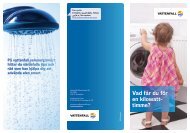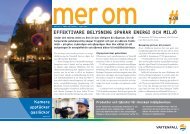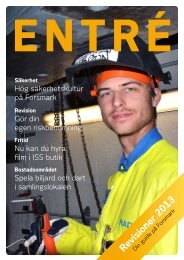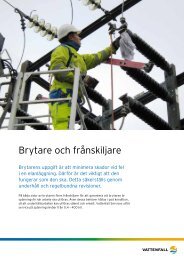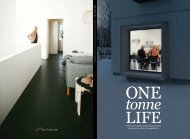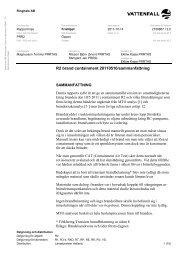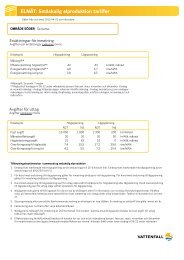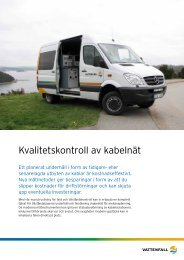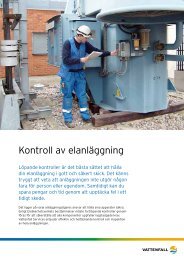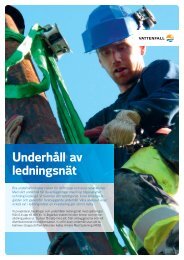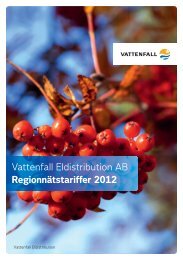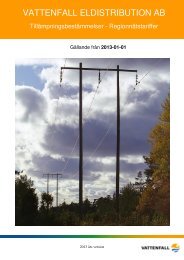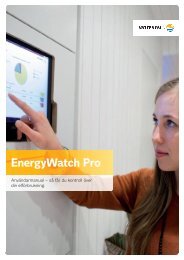This environmental impact assessment for Kriegers flak ... - Vattenfall
This environmental impact assessment for Kriegers flak ... - Vattenfall
This environmental impact assessment for Kriegers flak ... - Vattenfall
Create successful ePaper yourself
Turn your PDF publications into a flip-book with our unique Google optimized e-Paper software.
80 PRESENTATION OF THE AREA<br />
regularly or sporadically within this group of stations.<br />
Below the halocline the stations were divided in two<br />
groups, ”B1” and ”B2”.<br />
The Þ rst group mainly contained sand seabed (station<br />
group B1). The stations within this group were<br />
mainly placed between 28-38 metres depth although<br />
some were at 40 metres depth. Common <strong>for</strong> all these<br />
stations was low organic content, the humus content<br />
was mainly less that 1 % of dry matter.<br />
The structural element in this group was the blue<br />
mussel M. edulis, which occurred at all stations in high<br />
density. Also the Baltic mussel M. baltica, the polychaet<br />
P. elegans and the crustacean Diastylis rathkei were<br />
observed at all stations.<br />
Nine further species were detected at more than half<br />
of the stations, <strong>for</strong> instance Saduria entomon, Monoporeia<br />
afÞ nis and Halicryptus spinulosus. Also these species<br />
are species that usually are limited to the cold and<br />
salt-rich waters below the halocline. The number of<br />
species in this type of biotope was very high. In total,<br />
62 different species and higher taxon were registered.<br />
A high degree of salinity, low water temperatures<br />
and sporadic incidents of oxygen shortage characterized<br />
those under water stations below a depth of 40 m<br />
which mainly constituted the group B2. In addition,<br />
organic substance in the <strong>for</strong>m of mud in hollow areas<br />
was accumulated, the humus content was measured to<br />
an average 3% and reached a maximum value of 10 %<br />
of dry matter.<br />
Five species could be observed at all stations in<br />
group B2: D. rathkei, H. spinulosus, M. balthica, S.<br />
armiger and the polychaet Terebellides stroemi. Also<br />
the mussel A. borealis, the polychaets P. elegans and<br />
Bylgides sarsi and also the Pontoporeia femorata and<br />
the Priapulus caudatus were widespread (presence<br />
of >75%). At more than half of the stations, the two<br />
species of polychaets, Aricidea suecia and Ampharete<br />
baltica, and the blue mussel M. eduli were found.<br />
11.6.2. Fish<br />
There are around 144 species of Þ sh in the Baltic of<br />
which 97 species are salt water and 40 species are fresh<br />
water Þ sh with 7 species alternating between salt and<br />
fresh water (Thiel et al. 1996).<br />
A survey carried out by IfAÖ on behalf of the Group<br />
on the German side of <strong>Kriegers</strong> Flak identiÞ ed the following<br />
27 species in the area:<br />
Cod, whiting, haddock, plaice, common dab,<br />
ß ounder, herring lumpsucker, eel, grey mullet, saithe,<br />
turbot, sculpi, snakeblenny, spratt, viviparous blenny,<br />
lumpsucker, blackgoby, rockgunnel, goldsinny-wrasse,<br />
shortspined and sea scorpio. (For latin names and family<br />
belongings, see Appendix 7.6.).<br />
None of these are listed as endangered speices in the<br />
Swedish register.<br />
The surveys were carried out during 2002 and 2003<br />
Overview over distribution of macrozoobentos in the south-western Baltic




